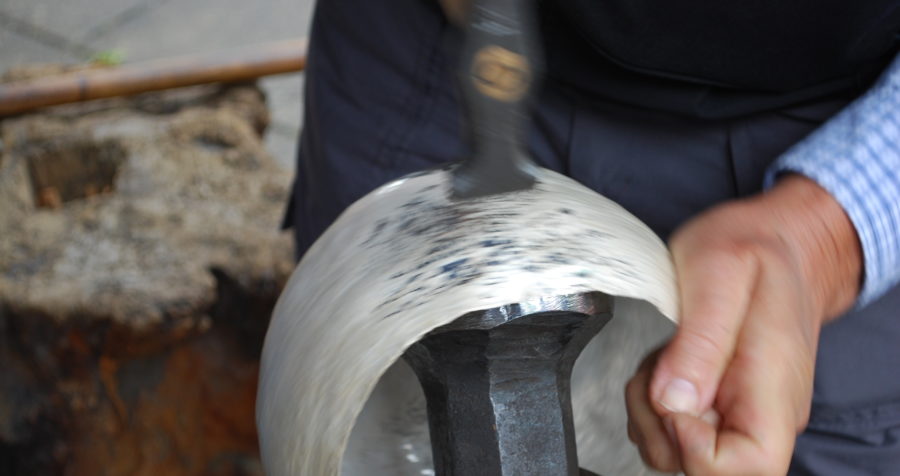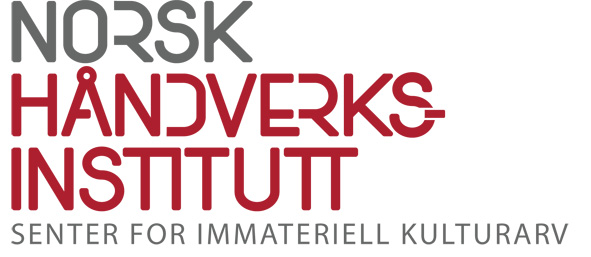A silversmith project and its effects

Background
Above: A silver bowl under construction. The HammerClub Meeting in Trondheim. Photo: Norsk håndverksinstitutt
The Church of Norway owns and manages a large collection of valuable handcrafted silver pieces such as candlesticks, vases and chalices. The objects are old. They provide insight into knowledge of old silversmith work and are often handcraft of superior quality.
Many pieces are used regularly, for example during church services. Their use exposes them to wear and tear and in worst case accidental damage.
The situation is worrisome, reported a goldsmith in South-Western Norway in 2005. Through time he had seen that the large collection of silver which the churches owned had deteriorated greatly, that the church treated the silver pieces casually as well as poorly and that there were few craftsmen left who were competent enough to restore the pieces or make new ones.
His initiative initiated the Silversmith Project, a documentation and training project under the direction of the Norwegian Crafts Institute. Each year the institute administrates a dozen projects under the label documentation and training. The goal of the projects is to transmit knowledge of traditional handcraft to new generations.
Documentation and training in the corpus work were the starting point of the Silversmith Project. This project became known as the Silversmith Projects because several projects grew out of it. The projects lasted from 2005 – 2015. During this period, the activities varied.
The documentation and teaching projects were arranged in different ways, dependent on the topic in question. In this instance, the Silversmith Project started as an ordinary project with one informant, one craft specialist and one documenter from the Crafts Institute. During the course of the project the craft specialist was supplemented with two additional persons from slightly different parts of the silversmith trade.
The silversmith trade is old with long-established traditions. Working with holloware requires a high degree of skill for the handcrafter. The silversmith of holloware hammers objects from silver sheets into a complete and finished product or into parts which later are assembled into a product.
Objectives
→Make a copy of two chalices belonging respectively to Hylestad Church and Flekkefjord Church.
→Preserve and impart silversmith knowledge in corpus work through:
- Calling attention to and interest for the trade
- Increasing the number of craftsmen within the corpus field
- Preserving knowledge
- Increasing the competence of the owners and custodians of old silver pieces
How it was done
The project period of ten years can be divided into phases.
A national focus: Hylestad and Flekkefjord churches.
A two-step process was used to copy the two chalices. First the chalice from Hylestad was copied then came the turn for the chalice from the Flekkefjord Church.
The original chalice from Flekkefjord Church, dating from 1609, was in a visible state of disrepair. At an earlier time it had been decided to make a new chalice.
It was drawn and measured.
The new chalice was made in three parts, lightly chased, and gilded in the cupa.

The new, handmade goblet with its cupa atop a stand, now in Flekkefjord church. Photo: BRKLYN / Hugo Skarsten Larsen.
A European focus: HammerClub Meeting
In Norway, there are but a few craftsmen in this trade. Together with the gold and silver milieu in Hanau, Germany, the project brought the trade into international focus. Together with the milieu, Norway’s Goldsmith Federation (Norges Gullsmedforbund) and the Nordenfjeldske Industrial Art Museum ((Kunstindustrimuseum) in Trondheim, all the silversmiths of holloware from all over Europe were gathered at a HammerClub Meeting.
The HammerClub is an informal community to serve the craft of silversmithing, established in 2002. Today silversmiths from various European countries and a wide range of silver enthusiasts are part to this community.The objective of the HammerClub is to present the art of silversmithing to a broad public, to establish contacts with collectors and museum professionals, and to share knowledge of technical developments as well as historical art and aesthetic aspects.

One of the projects at the HammerClub Meeting: A silver bowl handhammered as a joint process by several silversmiths. Photo: Audbjørn Rønning/Maihaugen
An international focus: the Silver triennale
In 2013, the International Silver Triennale came to Norway (Trondheim). The triennale was made up of three parts: practical work, judging of the objects and exhibitions. In total more than 140 pieces were exhibited. Most of the people who submitted their work together with other craftsmen were present at the opening.
Competence and placement of responsibility on those making an order and their awareness of liability
Based on an idea from Denmark to become aware of the responsibility of the large silver collection which the churches possessed, The Church’s Employers’ Association (Kirkens Arbeidsgiverforening) was contacted to collaborate with restoration and new acquisitions of silver corpus pieces. From the work a booklet about the church’s responsibility was published. All the church owners have received this booklet. Through the register of craftsmen at the Norwegian Crafts Institute, the church owners are made aware of the craftsmen who can take on the task of restoring and making new objects in corpus.
Today the largest collections of silver are publicly owned, either in museums or through the church but also private individuals have large collections. The owners and custodians have a responsibility, but this also applies to the craftsmen.

The alter prepared for ceremony with the new goblet and lit candles. Flekkefjord Church. Photo: Bernt Kristian Lauvdal.
Conclusion
Two chalices were produced during the project. A novice took his third craft certificate in the gold- and silversmith trades with the one chalice as the specimen to qualify as a journeyman.
The project contributed to the large gathering for silversmiths of holloware and a world-wide exhibition of holloware.
Continual emphasis and active awareness within the craft is vital both to protect the pieces, make new pieces and to maintain a certain number of silversmiths of holloware.
Key factors
1. The triangle model
The triangle model consists of the master, his/her novice and the documenter. The master is the bearer of know-how of several generations and part of a living tradition. The novice is the potential new master, intending to learn what the master is able to teach him. This model is inspired by the old master-novice relationship, but transported into a modern context, inter alia due to the role of the documenter.
2. Flexible use of the triangle model
The triangle model is the theoretical basis of a training process. It needs to be adjusted to suit certain situations, as was the case in the Silver Project.
3. Actionborne knowledge
Action-borne knowledge is the sum of experience and skills that has been passed on from one generation to another in a knowledgeable fellowship of action and culture. Both craftsmanship, patterns of acting and perceptions are inherited from generation to generation. In the transmission of action-borne knowledge, the basic learning is copying combined with experimenting and personal experience.
4. A dedicated novice
The novice already had two craft certificates as a goldsmith and filigree crafter and also a master certificate. His motivation to acquire a third craft certificate, this time in the holloware craft with a chalice as his specimen to qualify, was a natural step for him.
5. Increasing awareness amongst the custodians
In the course of the project, a pamphlet about the care and maintenance of the church silver was published and distributed to the respective owners and custodians.

